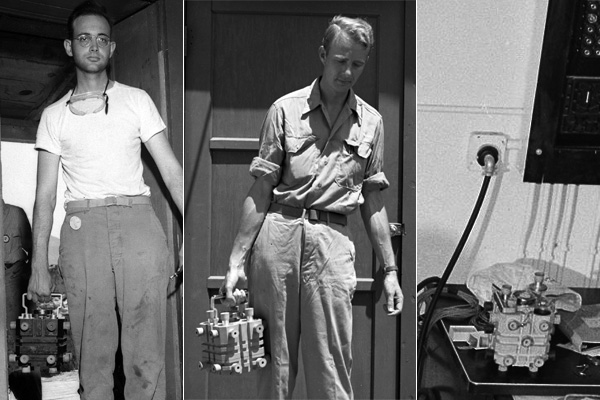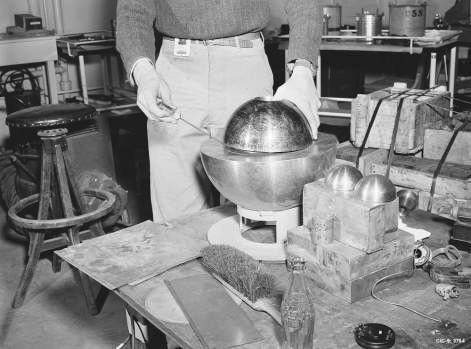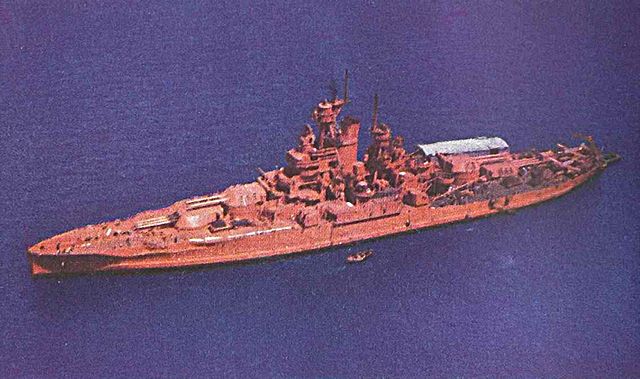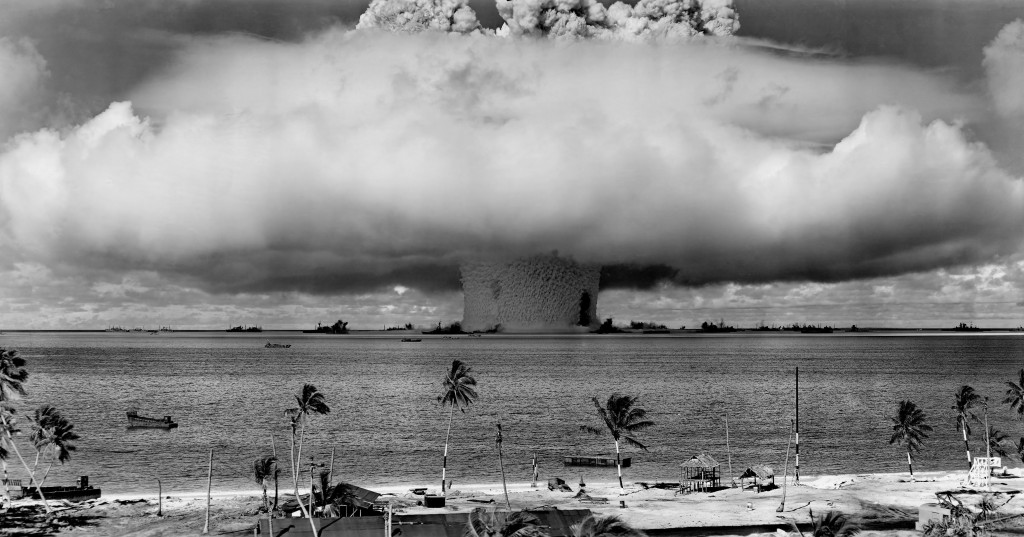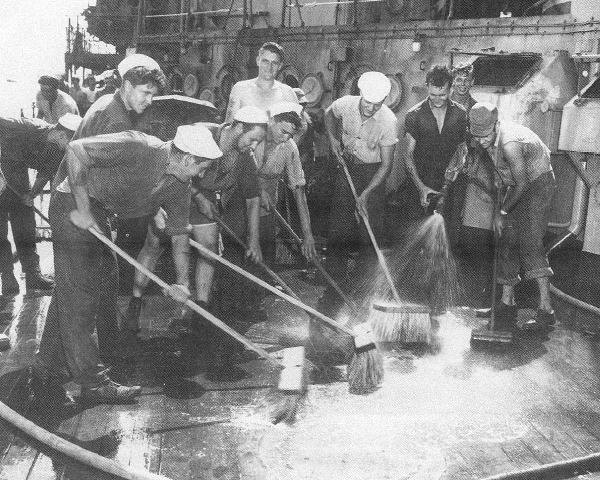At the start of its metal life, it was just the Third core, as it was the third in the family. Here is the entire family of plutonium cores, dressed up in fashionable magnesium casings:
The oldest one is on the left, the Gadget core. It exploded at the Trinity test site in the first-ever atomic blast.
The younger brother is in the middle, the Fat Man core. It exploded over Nagasaki and killed 40,000-80,000 Japanese civilians.
Missing from these pictures is the Little Boy core, the black sheep in the family. A fat blob made of 64kg of uranium, it dwarfed smaller 6.2kg plutonium cores. But as black sheeps often do, it achieved the biggest fame. It exploded over Hiroshima.
On the right is the youngest and the hero of our story. Actually, the photo only shows its magnesium casing; the third core was busy elsewhere. Japan surrendered in August 1945, and there were no plans for another atomic bombing. So it was used at the Los Alamos lab for criticality experiments:
Its future seemed quite boring compared to its older brothers, but the Third core had its own plans. The first accident happened on August 21, 1945.
To understand what happened, we need to understand what a criticality experiment is. A critical mass is the smallest amount of fissile material needed for a sustained nuclear chain reaction. All plutonium cores are built dangerously close to that limit. The Third core was at 95% of its critical mass. So it was safe; you could use it for bowling if you wanted. But this is the trick: you can make it go critical by compressing it with high explosives, which are used in implosion-type nuclear bombs. However, blowing stuff up is not very practical in lab environments, as you need your core and your scientists to be undamaged for the next experiment. In Los Alamos, they used neutron reflectors to simulate the first nanoseconds before the explosion. Surround part of the core with tungsten carbide bricks, and they reflect neutrons back in. The same core is now 96% critical. Keep adding bricks around, like Legos, and you will reach 97% and 98% criticality. One more brick, and you will be at 99%. One percent away from an uncontrolled chain reaction. But this is a mechanical, simple procedure done by the smartest physicists in the country. What can go wrong?
That day in August, physicist Harry Daghlian was doing a criticality experiment. He was alone, with a security guy sitting at a nearby desk. He started adding bricks and measuring the resulting radiation. Understanding the thin border of criticality is crucial. The faster the criticality happens, the better yield a nuclear weapon has. He was quite close to the border when a funny thing happened. The tungsten carbide brick slipped from his sweaty hand and fell on the core. The room started glowing electric blue. While Harry was panickingly disassembling the pile of bricks, the security guy was asking himself, what the hell is happening? It lasted only a few seconds before the hot core was stripped naked, and the reaction stopped. All was silent. The two men reported to the hospital soon after. Harry Daghlian died 25 days later from acute radiation syndrome. Private Robert Hemmerly died 33 years later from leukemia.
This accident caused quite a stir in Los Alamos. Protocols were put in place to prevent future accidents. During lunch in the canteen, scientists would imagine mental experiments in which the core would go critical again. What is better–to quickly dismantle the core apparatus or to run away as fast as you can? If you leave slightly critical core, it would melt on the laboratory floor, and the reaction would stop. Of course, it takes more seconds to run out of the lab than to manually stop the reaction, but the calculation is not so simple. Radiation falls rapidly with the square of the distance, so with every step you run, the situation becomes much less dangerous. As real geeks, they calculated that prompt manual dismantling is the best choice because you just can’t run fast enough.
One of the physicists at those lunches was Louis Slotin. He was a young and cocky Canadian, often seen in his trademark blue jeans and cowboy boots. Not only he was unafraid, but fiddling with core also gave him a kick. In the new experiment, they ditched the bricks and replaced them with a neutron-reflecting beryllium half-sphere. If the core is completely covered, it goes critical. Therefore, mechanical spacers are put into place to ensure that the half-sphere only covers a certain percentage of it. Louis didn’t like spacers. He would perform criticality measurements holding a half-sphere top thumb hole with his left hand and holding it in position with a screwdriver in his right hand:
The scintillation counter on the side would show how far he could go. It was immediate and much faster than using spacers. Slotin called it “twisting the dragon’s tail” and performed it over a dozen times in front of spectating scientists. Enrico Fermi reportedly told Slotin and others that they would be “dead within a year” if they continued performing it.
On May 21, 1946, Louis was preparing to twist the dragon’s tail in a room with eight other people. Everything was going nicely. He slowly covered the core with a beryllium half-sphere until it was almost enclosed. The scintillation counter was happily ticking, and Louis was controlling the neutron-escaping gap with his screwdriver. Suddenly the tip of the screwdriver slipped, and everybody heard the metal cling of the half-sphere closing. The room filled with the blue light. Louis hastily kicked the half-sphere. The blue light was replaced with a deadly silence. They quickly left the room. After 10 minutes, they all decided to go back. With a piece of chalk, they marked where everybody stood at the moment of criticality. They were scientists, after all; this unplanned experiment would offer a rare opportunity to measure the effects of radiation poisoning on eight human subjects of varying age and varying distance from the radiation source. After diagramming, they reported to the sick bay. The first result followed soon, as Louis Slotin died nine days later. Others survived, but suffered from various radiation-related illnesses.
Nothing happened to the core, except for the name change. Older cores that killed more than 130,000 people far across the Pacific still had cute names like the Little Boy and the Fat Man. But with two dead colleagues, everybody at Los Alamos started calling this one the Demon core. Hands-on criticality experiments were halted and replaced with remote-control machines supervised from a quarter-mile distance.
Ultimately, it was decided to destroy the Demon core in a nuclear blast–for both the scientific value and publicity purposes. Marshall islands were chosen as the location of the first nuclear test where press and selected audience members were allowed. In the first of three planned explosions, the Demon core was to be dropped from a plane over a fleet of 95 decommissioned target ships. The zero point was a few hundred meters was above the USS Nevada, which had been painted bright red for targeting purposes:
On July 1, 1946, as 114 journalists were waiting for an atomic explosion, the rough expectation was for nine ships (including two battleships and an aircraft carrier) to be sunk. Again, the Demon core had other plans. For reasons still unknown, the bomb missed the target by 650 meters. When the plutonium imploded and went critical, it was too far away to do any real damage. The test was a flop, and the press was disappointed. The New York Times reported that of all of the ships, “only two were sunk, one capsized, and eighteen damaged.”
The curse didn’t stop with the demise of the Demon core. The second test seemed more certain, as it was an underwater blast. The position was certain, and water carries more blast energy. On July 25th, a bomb named Baker was detonated 27 meters below the sea’s surface. Here is the photo (click for a large version); notice a black hole where the 27,000-ton battleship USS Arkansas was:
The blast was a success, but the events after were far from that. Because of the underwater nature of the test, all radioactive fission products remained in close proximity. The entire lagoon and target ships were radioactively contaminated. Ships were needed for a third test, so Navy fireboats were sent to do decontamination. They soon discovered that hosing down ships with water from the lagoon (also radioactive) didn’t help much. The Navy then sent 4900 sailors who tried scrubbing ships with water, soap, and lye:
It didn’t work. The ships were still radioactive, and even worse, plutonium was everywhere. They caught a surgeonfish that had ingested enough plutonium to make its own x-ray on a film, without an x-ray apparatus. On August 10th, decontamination was canceled. The third test was never performed, and most of the target fleet was brought to open sea and sunk. So instead of being a demonstration of the US’s nuclear superiority, these two tests demonstrated that the US army couldn’t hit the target, estimate the fallout, or perform the cleanup.
This should be the end of the story of the misbehaved plutonium. But it is not, as it continues with the strangest twist.
That same year, in faraway France, two men were competing to push the boundaries of female fashion. After WW2, the feeling of liberation was in the air, for both sexual freedom and for a new, emancipated role of females in society. They both came to a similar idea–a two-piece swimsuit that covers only the minimum. Jacques Heim launched his swimsuit in June 1946, a few weeks before the Demon core exploded. Appropriately for the spirit of the times, he called it Atome and marketed as “the world’s smallest bathing suit.” This would not be for long because a few weeks later, Louis Réard, another Frenchman, decided to go even further. He concluded that there is no place for the belly button taboo in the “atomic age.” On July 5th, 1946 he unveiled his design that showed the navel for the first time. It was few days after the US nuclear test, and Réard got an idea. On July 18th he registered the name Bikini, as that was the name of atoll where the test took place. The rest is history; both the swimsuit and the name caught on, to the point that “bikini” became a generic name for a female swimsuit. Common assumption that the name “bikini” was given because of a historical or associative connection to the tropical islands, is not true. People on Bikini Atoll didn’t wear bikinis. And French had plenty of their own tropical islands.
So every time you see a bikini, remember that its name comes from a series of unfortunate events that include one plutonium sphere, one sweaty hand, one slipped screwdriver, and a whole bunch of ghost ships that just wouldn’t sink.
Links
